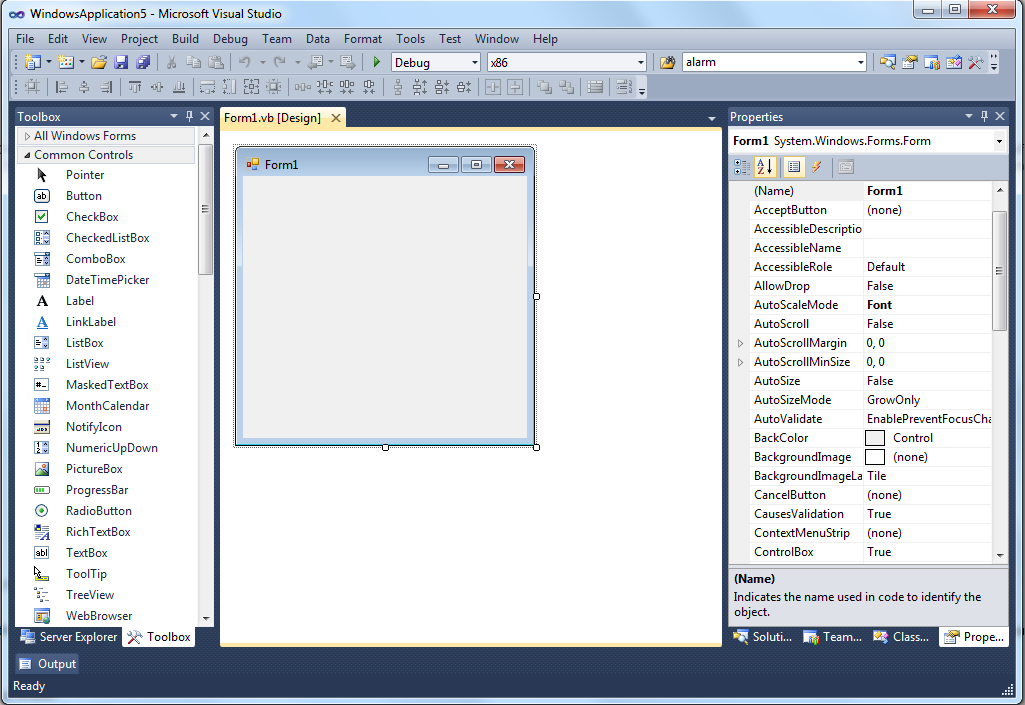Visual basic environment is an IDE (integrated development environment) of Microsoft. Graphical user interface is used with a basic programming language; it is a first product to provide a graphical programming environment for developing a user interface.
Visual Basic uses several types of procedures:
- Sub Procedures perform actions but do not return a value to the calling code.
- Event-handling procedures are sub procedures that execute in response to an event raised by user action or by an occurrence in a program.
- Function Procedures return a value to the calling code. They can perform other actions before returning.Some functions written in C# return a reference return value. Function callers can modify the return value, and this modification is reflected in the state of the called object. Starting with Visual Basic 2017, Visual Basic code can consume reference return values, although it cannot return a value by reference. For more information, see Reference return values.
- Property Procedures return and assign values of properties on objects or modules.
Operator Procedures define the behavior of a standard operator when one or both of the operands is a newly-defined class or structure.
Generic Procedures in Visual Basic define one or more type parameters in addition to their normal parameters, so the calling code can pass specific data types each time it makes a call.

SET VISUAL BASIC ENVIRONMENT OPTIONS
We can set the behavior and look of the Visual Basic development environment by using the options Dialogue box Use the :
Editor Tab : To specify code window and project window settings.
Format Tab : To specify the appearance of your code.
General Tab : To specify form, error handling, and compile setting for your project.
Docking Tab : To specify whether a window is attached or "anchored" to one each of the other dock able and application windows.
To set environment options, on the tools menu of the Visuals Basic Editor, choose options. Each options is described in the following sections.
Editor Tab
Auto Syntax Check : Visual basic automatically verifies correct syntax after you enter a line of code.
Require Variable Declaration : Explicit variable declarations are required in modules.
Auto Indent : After tabbing the first line of code, all subsequent lines start at that tab location.
Tab Width : The tab width, which can range from 1-32 spaces. (Default is 4 spaces)
Default to full module view : Procedures for new modules are displayed in the code window as a single, scrollable list or one procedure at a time.
Procedure Separator : Display separator bars at the end of each procedure in the code window.
Auto List Members : At the insertion point, Visual Basic displays information that logically completes a statement.
Auto quick info : Information about functions and their arguments is displayed as you type.
Auto Data Tips : Automatically display the value of any variable on which you place the mouse pointer. Available only in break mode.
Drag-Drop in Text Editing : Code elements can be dragged from the code window into the immediate or watch windows.
Editor Format
Foreground, Background and Indicator : The color of different categories of text listed in the code colors list.
Font : The font used for displaying code.
Size : The size of the font used for code.
Margin Indicator Bar : Display the Margin Indicator Bar.
General Tab
Show Grid : Display a grid on a form.
Grid Units : List the unit of measurements for units in the grid.
Width : The width of the grid cells on a form.
Height : The height of the grid cells on a form.
Align Controls to Grid : Automatically position the outer edge of controls on the closest grid lines.
Show ToolTips : Display tooltips for toolbar buttons.
Collapse Proj. Hides Windows : Automatically close the project. UserForm, object, or module windows when a project is collapsed in the project explorer.
Notify Before State Loss : Display a message that a requested action will cause all module level variable to be reset for a running project.
Break on All Errors : Any error causes the project to enter break mode, whether or not an error handler is active, and whether or not the code is in a class module.
Break in Class Module : Any unhandled error produced in a class module causes the project to enter break mode at the line of code which produced the error.
Break on Unhandled Errors : Any other unhandled error causes the project to enter break mode.
Compile on Demand : A project is fully compiled before it starts, or code is compiled as needed.
Background Compile : Use idle time during run time to finish compiling the project in the background (available only if Compile on Demand is set).
Docking Tab
The Checkbox for the appropriate window : The window can be anchored to an adjacent dock able window or the Visual Basic Editor window.
How To Customize VB Editor Environment?
Watch this Video.....👇😊
Source...👉TrumpExcel👈
MODEL QUESTIONS
Q.1. What is Visual Basic? Write the features of VB.
Q.2. Write notes on:
a) Visual Basic Events
b) Visual Basic Event Procedures
Q.3. Is VB a fully object oriented programming. What VB can and can't do? Explain.
Q.4. Why VB is called event programming language?
Q.5. Explain About Visual Basic environment options.



